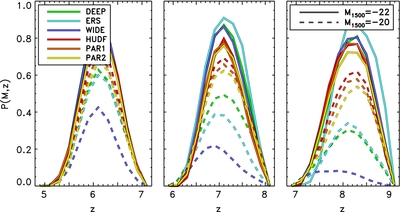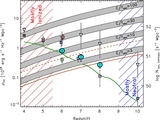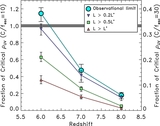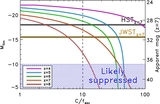Image Details

Caption: Figure 2.
Summary of our completeness simulations. Each panel represents one of our redshift bins of z = 6, 7, and 8 from left-to-right. Each panel contains the probability of recovering a given galaxy (as a function of redshift and M 1500) for two magnitude values; M 1500 = −22 (solid line) and M 1500 = −20 (dashed line). At z = 6, 7, and 8, M 1500 = −22 corresponds to apparent UV magnitudes of 24.7, 24.9, and 25.1, and M 1500 = −20 corresponds to 26.7, 26.9, and 27.1, respectively. While all fields can efficiently detect bright galaxies at any redshift, only the two HUDF09 fields can efficiently detect fainter galaxies at higher redshift, which is consistent with our recovered distribution shown in Figure 1. Although the HUDF09 fields are more efficient than the CANDELS Deep and ERS fields for fainter galaxies at z = 6, the much larger area probed by the latter fields results in their dominating the sample at that redshift. We note that although they are of comparable area, the volume probed by the WIDE field is much less than the ERS. At fainter magnitudes, this is due to the increased depth in the ERS. However, even at bright magnitudes, the ERS is more complete at z = 7 and 8, as the F098M filter used in the ERS does not overlap with F125W (while F105W, used in the remaining fields, does), allowing more precise photometric redshifts.
Copyright and Terms & Conditions
© 2012. The American Astronomical Society. All rights reserved.









